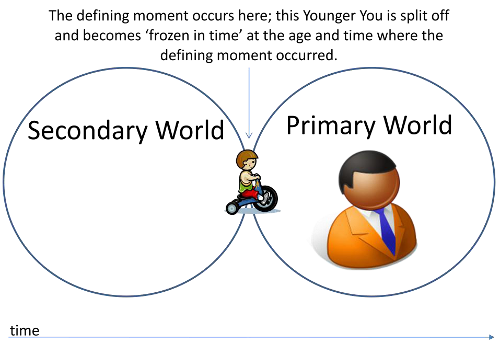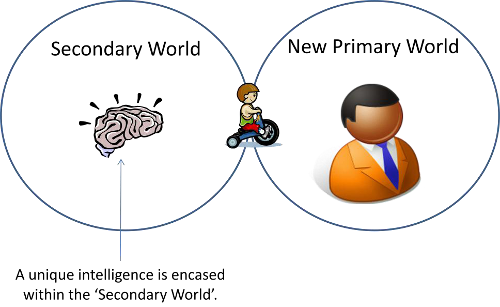Table of Contents
Secondary Worlds
Introduction
These are the worlds that are created at points in our chronological life when we are forced, through an event, circumstance or a defining moment in our lives (usually trauma), to change our sense of being, our ontology1) to such a degree we can no longer be who we were. Metaphorically the boundary conditions (rules and structures) that made up and protected our Primary World have been broken.
Trauma
Donald Winnicott had his own idea about this concept. He said that when the environment impinges to this degree, it is an ‘annihilation of being’, hence that original ‘beingness’ can no longer ‘be’, and another has to take its place, one that has sufficiently developed to allow for this unpredictable event (impingement).
“Trauma is an impingement from the environment and from the individual’s reaction to the environment that occurs prior to the individual’s development of the mechanisms that make the unpredictable predictable.” - D.W.Winnicott
Quote from Boundary and Space (pg. 58) - (1967) ‘Clinical Regression Compared with Defence Organisation’
At this moment of creation, a new Primary World is conceived out of the metaphorical landscape of this younger you whilst in that defining moment.
These Secondary Worlds then become ’Lost Worlds’, and our prior ontology (the beliefs and resources that used to be our Primary World) is held within them. It is as though the internal construct/set of boundaries had to break, as they could not contain or classify the new information that had impinged upon the individual. It is at this point we re-evaluate and build new boundaries, new constructions, and new categories to allow for this radical shift in our world.
These Secondary Worlds contain the information that we need, and can be helpful to us in resolving the problems in the here and now. However, we do not have direct access to them, they are outside of our Primary World.
Fragmentation
Also held within these Secondary Worlds are aspects/fragments of ourselves that were split off and left behind (frozen in time) when the new Primary World was created. It is these ‘lost’ parts of us that communicate, through symptoms in the here and now. These symptoms are simply unsuccessful attempts from the mind-body at resolving the issue.
During the journey of Emergent Knowledge these parts of us are given the opportunity to communicate through other channels, the semantics or words we use, non-verbal gestures, visual metaphors, somatics or feelings and the scribbling and drawings of the client. These younger manifestations of you are already indirectly communicating through these channels. In fact before Emergent Knowledge processing nearly all of our general communication is from these younger manifestations.
This concept of being ‘frozen in time’ makes perfect sense when considering the moment of trauma, because this younger you stays back in that moment just prior to the trauma as a natural defence against the trauma of an unthinkable anxiety, hence it is a way of relating to reality without betraying the ‘True Self’ or The Pristine.
(see also The Structure of Early Fragmentation.)
How Secondary Worlds Evolve
We begin our life with our first Primary World. However, this Primary World has to evolve and become more advanced and complicated to adapt and adjust to match the ever-changing new real world, both within the womb and once we are born.
Winnicott proposed that a baby has no distinction between itself and its environment (including Mother) during the first weeks of life, they are the same; the state of omnipotence continues but only intermittently, at first the baby wants food and a breast or bottle is provided. The baby’s internal world wanted something and the external reality matched it, and the state of omnipotence continues.
However, there will come a moment when baby wants food. The baby makes all the successful noises and movements of the past, but food does not appear. The Primary World the baby once knew can no longer exist; the environment has impinged and broken the boundaries of the baby’s world.
Here the baby is beginning to realise that it is separate from the external reality, it is becoming self-aware. Watch a baby observe and experience its own hands and feet as they move. The baby is becoming an individual, recognising there is an inside and an outside, with a limiting membrane in between (the skin).
This process of separation between the external world and the internal world is also a process of integration; where ‘true integration’ is defined as:
True integration is when the environment becomes permanently external; this is achieved once the individual has:
- Become orientated in 3D space
- A sense of finite time
- A sense of process
- A sense of scale
At this point we are fully aware of what is ‘Me’ and what is ‘Not-Me’.
The evolving state, where the environment has a positive reflection on the individuals Primary World allows the boundary of that Primary World to grow and expand, providing safety and security. It is possible, therefore, for a highly positive experience to change the nature of our being. We may find love we never thought existed, we may have a spiritual experience, we may perform a random action in the world and suddenly realise our potential.
Taking the Emergent Knowledge journey takes advantage of this potential for positive re-alignment in the Primary World.
At the point where the environment has a negative effect, i.e. impinges causing a defining moment, we can no longer be who we were as represented by our internal world, this is the ‘annihilation of being’ that Winnicott described. At the defining moment, you lose both the original you and the worldview that contained that you; it becomes a Secondary World obscured and separate from the new Primary World, which has been born in the mind the very next moment. This new world begins developing again with a new you, as an observer; you have effectively split.
That previous part that was safe and secure stays behind in what is now a Secondary World preserving the ethos of that era, the safety and security that the younger you knew. The new part develops a ‘New World’ and a new you to try and be better fitted for the real world that now exists, after the defining moment. This new real world is now categorised and filtered by this new development.
As this new Primary World begins to develop there are two observer positions that inhabit this world (see Figure 4):
- One in whose mind this world was created and is now ‘frozen in time’
- One in the here and now
Figure 4
The consequence of this process is that we have a large part of our mental history and sense of being (ontology) unable to participate in the new world order.
These Secondary Worlds contain useful information and positive wisdom. However due to the structure of our model, the negative memory of that defining moment is having a greater impact (i.e. shielding us from the Secondary World) than the positive wisdom existing in the Secondary World.
This gets even more interesting when we consider that in our Primary World we wish to remove the negative symptoms / memory, however to the younger you held within that Secondary World, the negative symptom is not negative, it is all that you knows and it is the process by which that you is keeping safe and secure in that World. It is preventing that you from re-experiencing the trauma again, this is the natural defence we discussed earlier regarding the unthinkable anxiety. We are effectively ‘frozen in time’ just prior to that defining moment.
This positive wisdom then, is cut-off from us or shut out from us, this is the wisdom (knowledge) that we don’t have direct access to, as these Secondary Worlds lie outside the boundaries of our Primary World.
Each of these Secondary Worlds is controlled by a unique intelligence encased within, which is at odds with the Core or True Self of who we are today. This intelligence may come from several sources such as the younger fragments of ourselves, our ontological, ancestral and spiritual influences (see Tertiary Worlds).
Figure 5
There are two boundaries shown in Figure 5:
- One encasing the world we are now in
- One that defines the world prior to the one we are now in
After we have given up this Secondary World, or in some cases had it ripped away from us, it becomes a ‘Lost World’ and the you that is held within calls out; he/she begins to perpetually communicate to the outside world, until the message is listened to and understood.
Here we present some examples of the language people use to describe an emotional experience of when this occurs:
- “I was beside myself with rage.”
- “I was out of my mind with worry.”
- “She made me feel like a child again.”
In the first two of these statements there are two I’s, one that is experiencing the rage or worry and is outside of the second I in the here and now. Note the association into the state of ‘rage’ and ‘worry’ and the spatial dissociation from ‘myself’ and ‘my mind’.
It may be useful to construct this as an I existing in the Primary World and an I which has become apparent from a Secondary World which has a thing called rage or worry in it.
In the last statement, the client has associated back into the child’s world, within their body. In this state they may be feeling small, out of control or even humiliation. This is an example of when our internal world is incorrectly scaled to the real world.
A figure of speech used by a person to describe their experience is thus translated literally into its metaphorical equivalent.
A Client Example
Here is an example from one of my clients; who was experiencing problems of insecurity and embarrassment, especially when in the company of women. Through our discussion of his problem, he stated that “It’s like I think they are above me and hold some kind of power over me.” This left him feeling confused and anxious.
Taking a Journey with Emergent Knowledge we discovered an early Secondary World where he had just joined a new school in the middle of the school year. In the school assembly a question was asked of all the children, which he couldn’t answer but he joined in and held up his hand anyway, to fit in; all those children with their hands up had to go to the front of the hall. He was confused as to why he was there; he was anxious about what would happen and as he began to blush and his safe and secure world broke apart, the teacher stood in front of him, towering over him. Demanding an answer as to why he was there, an answer that he didn’t have.
It can be seen how the feelings held within this Secondary World are currently showing up as problems in the Primary World, and also how the scaling of the Secondary World has carried through to the Primary World. He was still seeing women as powerful and above him. In can be seen here how our Secondary Worlds exert at differing times an influence on our relationship with the real world.
Where The Knowledge Resides
When we are discussing our problem from the you in the Primary World, it is not that our perception of the problem is wrong; it’s just that it is irrelevant. When a facilitator is asking questions like “How do you feel about …?” they are of no or very limited value to the client, because that you in the Primary World doesn’t have access to a useful answer from that position.
next –> Tertiary Worlds

